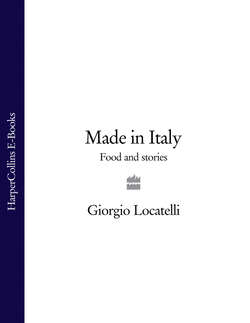Читать книгу Made in Italy: Food and Stories - Giorgio Locatelli - Страница 66
Salami
ОглавлениеSalami really began its life as the food of the poor. The lean cuts of the animal would be sold to the rich, and whatever was left over would go into salami, along with whatever herbs and spices you had locally. Originally, everything would have been chopped by hand, and in many places it still is. In Toscana, for example, the typical coppa di testa is made with practically the whole head of the pig: the tongue, cheek, skin, ear, everything.
To make salami, you need lard, or hard fat, which is cut into pieces, like nuggets of white marble, which won’t go rancid in the way that soft fat can; and the best salame achieve the perfect balance between meat and fat. The mixture is forced into the casing or skin of the salami (i budelli), which is traditionally the intestine of the pig, but may be synthetic. Once the salami has been forced into its ‘sock’ or skin, and tied with string, it is hung up in carefully controlled conditions for 2-4 months, to cure and dry. During this time it forms le muffe (mould), which should be uniform all the way over the surface of the salami (and all the same colour), leaving no gaps to allow air in, as this could cause the salami to become rancid. This ageing process, which contributes so much to the final character, is called ‘la stagionatura’.
For a simple family lunch, I like nothing better than a good salami with some bread, a little salad and some balsamic onions or other sottaceti (pickled vegetables). You can serve salami at dinner and then that is one course you don’t have to think about. I would always choose salami over prosciutto, perhaps because I still have a special memory of going up into the mountains with my granddad, when I was small. We would buy some bread, and a salami cacciatore – these are the little ones from my region of Lombardia that are not much bigger than a plump sausage and that hunters would carry in their rucksacks – which he would slice with his knife; and it was the best taste out in the open air. On a picnic, even now, I can’t think of anything better.
If you were to ask me now which is my favourite salami, I guess I would have to say salami di felino, the long one made in Emilia Romagna, which is a very straightforward salami, the first one you are given to have in your panino when you are very young. It is made with coarsely minced pork, seasoned only with salt and peppercorns and, usually, no garlic, so it is quite sweet-tasting and still moist in the middle. But there is no salami I don’t like; and there are so many to choose from, varying in texture: some are soft; some are like dry sticks of meat. In the South, you often find less salty salame, made with more chilli; peppercorns and, occasionally, light smoking are favoured in the North. In Toscana, they like to flavour their salame with fennel seeds (salame toscano finocchiona or sbriciolona).
They say this salami was first made by the farmers in order to sell their wine that wasn’t so good. The fennel seeds have an anaesthetic power over your taste buds, so when you came to the farm to taste the wine, they would first offer you a slice of the finocchiona, so that the flavour would disguise the poor quality of the wine.
On holiday in Calabria I tasted ’nduja from Spilinga for the first time (strangely, the name ’nduja comes from the French andouille). It is a soft (morbido), almost spreadable, salami: a mixture of pork and offal, chopped with a knife, with a lot of chilli, which goes inside the pig’s intestine and is lightly smoked over wood, then matured. You spoon it out and mix it with some pasta, or have it on bread. My son Jack would come back from swimming in the sea all afternoon and tuck into it as if it was peanut butter or chocolate spread.
